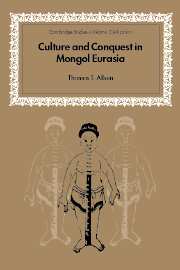Book contents
- Frontmatter
- Contents
- Preface
- Note on transliteration
- Abbreviations
- PART I BACKGROUND
- PART II POLITICAL–ECONOMIC RELATIONS
- 3 Formation of the Il-qans, 1251–1265
- 4 Grand Qans and Il-qans, 1265–1295
- 5 Continuity and change under Ghazan, 1295–1304
- 6 Sulṭāns and Grand Qans, 1304–1335
- 7 Economic ties
- 8 Overview of the relationship
- PART III INTERMEDIARIES
- PART IV CULTURAL EXCHANGE
- PART V ANALYSIS AND CONCLUSIONS
- Bibliography
- Index
- Other titles in the series
3 - Formation of the Il-qans, 1251–1265
Published online by Cambridge University Press: 04 September 2009
- Frontmatter
- Contents
- Preface
- Note on transliteration
- Abbreviations
- PART I BACKGROUND
- PART II POLITICAL–ECONOMIC RELATIONS
- 3 Formation of the Il-qans, 1251–1265
- 4 Grand Qans and Il-qans, 1265–1295
- 5 Continuity and change under Ghazan, 1295–1304
- 6 Sulṭāns and Grand Qans, 1304–1335
- 7 Economic ties
- 8 Overview of the relationship
- PART III INTERMEDIARIES
- PART IV CULTURAL EXCHANGE
- PART V ANALYSIS AND CONCLUSIONS
- Bibliography
- Index
- Other titles in the series
Summary
In 1206, after decades of struggle with rival tribes of the eastern steppe, Chinggis Qan proclaimed the formation of the Great Mongolian State (Yeke Mongghol Ulus), a polity which in the course of three generations became the largest land empire in world history. The empire began its expansion southward, launching a series of campaigns against the Tanguts and the Jürchen Chin dynasty which culminated in the capture of Chung-tu (Peking) in 1215. The commercial overtures of the Khwārazmshāh Muḥammad in 1218 turned Mongolian attention westward. The incident at Utrār, where a Mongolian caravan was despoiled by Khwārazmian officials, led to an invasion of Transoxania in 1219. Between 1220 and 1221 the armies of the Khwārazmshāh were overwhelmed and West Turkestan and Khurāsān ravaged and subdued.
Chinggis Qan returned to Mongolia in 1224 to organize further campaigns against the Tanguts and died three years later in the midst of these operations. This necessitated a temporary halt in military expansion while the Chinggisid princes and their advisers assembled in Mongolia to confirm Ögödei, Chinggis Qan's third son and designated heir, as the new qaghan (r. 1229–41). Operations were restarted in 1229 to complete the conquest of West Asia. Progress was substantial: Mongolian armies forced the capitulation of the Armenians and Georgians in 1236 and the Seljuqs of Rūm in 1243. Under Güyüg (r. 1246–48), Ögödei's son and successor, expansion was, however, slowed in the face of increased tension among the imperial princes.
- Type
- Chapter
- Information
- Culture and Conquest in Mongol Eurasia , pp. 17 - 23Publisher: Cambridge University PressPrint publication year: 2001



